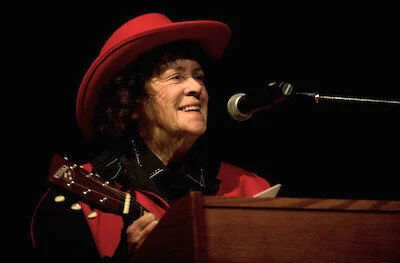Ask a Cowboy Poet
June 2021
Here at the Western Folklife Center we’ve been fortunate enough to forge relationships with wise wordsmiths and performers from all over the world. What better time to reach out and tap into this wealth of insight, wit, and humor than now! You send in your big (or small) questions and we put them up to the pros. We hope that our columnists, including Dick Gibford, Yvonne Hollenbeck, Bill Lowman, Waddie Mitchell, Gwen Petersen, and more, can help you find the answers you’re looking for. Got a question of your own? Email us at media@westernfolklife.org.
Share the link with others and keep the conversation going!
“
Greetings all,
What was the toughest drought you faced, in what year did it happen, and what did you do to get through it? If you faced the same drought again would you do anything differently?”
—Jonathan Odermann
Dick Gibford:
Back in 1987, we had a drought here on this outfit that lasted three years, had to cull the herd down more than we wanted to, feed more hay in the winter and early spring, and of course ride this rough country a horseback more, workin’ on trails, and springs, water systems, etc. If we had another one like that one it would put us out of business just about, as me and the boss are getting a lot older now, and likely couldn't handle the bigger work load! But that’s alright with me, we have had a good run, and I would have a lot more time to braid and sell my rawhide gear and write poetry and books!
Photo courtesy of Jessica Brandi Lifland
Yvonne Hollenbeck:
In 2002, our area was in a terrible drought period, some records indicate the driest year in the past 100. Of course, as is usually the case, the fire danger was high and there were many devastating fires that consumed precious grass and hay supplies. We culled heavy and fortunately had left over hay and bought a lot of hay from a neighbor who sold his cows. That got us through.
We had a community meeting with the local sheriff and fire chief and made a call list for every community for quick notification if fire did happen. Practically every farmer and rancher had pickups loaded with sprayers and fire fighting equipment, and because we are so far from town, the local CoOp filled huge tanks with water and parked them for easy access in many rural areas, as creeks, lakes and ponds were very low.
To prepare for future droughts, we try to have a year’s supply of hay on hand in numerous stack yards. We have a fire fighting unit ready to go at all times. There is nothing anyone can do to prevent a drought but pray and wait on Mother Nature to bring rain.
Photo courtesy of Charlie Ekburg
Bill Lowman:
1961, 1977 and 1988 were the three worst drought years in my life time. I was just a freshman in high school in 61, so my parents dealt with it. 1977 was severe. Already an accomplished heavy equipment operator, I secured a job rebuilding a state highway at top wages and JoAnn joined in as a highway traffic flagger on a project only thirty miles from our ranch. We both worked at ranching during the evenings, late into the nights and hard and fast on weekends, being glad to go back to work on Mondays “to get some rest.” It provided income “off the ranch” to purchase a winters supply of hay and cow cake.
1988 was terrible, we threw all pasture gates open, normally we save half of our pastures for fall and winter grazing. The U.S. Agriculture Department had that Conservation Reserve Program in motion for the farmers to “set aside” acres from production and issued an emergency drought release to be hayed, so we ranchers in the badlands of “Cowboy Country” went out on the flats on the North Dakota/Montana border and put up poor quality CRP hay. Most of my neighbors shipped all their cattle out to the northern Minnesota “brush country” for the summer. We didn’t. The single reason we never “over stock” our range, even on a wet year. Although the entire 80’s decade was marginal, luck has been that I have never seen two extremely drought years back-to-back.
Since then, we have purchased several hundred acres of good hay ground out on “The Flats” along with the good fortune of many back-to-back-to-back extremely good hay production years; we have built a “safe guard” of carry over hay, sometimes up to two years. After a very dry winter and spring of 20-21, timely early May, slow “soaker” rains have trumped out any equal to the past.
We are a family owned ranch, managing our own business from A to Z in contrast to corporate owned outfits of “Buckaroo, day work hands.”
Photo courtesy of Jessica Brandi Lifland
Waddie Mitchell:
I believe it was 1991 and we were awful dry in Elko county. There had been a few dry years prior which makes a full out drought all that much harder. The owners were luckier than some in that we hadn’t had to use the grass too hard prior to that year. Though we did end up using the range, meadows and haystacks harder than we liked, got through. Also we had creeks and a river and didn’t have to pump our stock water so nature didn’t keep us from using outlying grasses seldom needed. A few ranchers in the county sadly had to sell a bunch of stock. They’d been buying feed but the drought out lasted them.
There is nothing harder to contend with (save the gov’t) than big snow or drought. Ma Nature rules agriculture. Always has, always will.
Elko county again faces a drought this year like none I know few have ever seen here. I wish the ranchers well. The only drought I have to contend now is a drought of ideas and don’t think I don’t know I’m lucky.
If I were in the situation to do it again, I would sell all the stock, take a long vacation, come home and go into some sort of venture where hikers, bikers, skiers, climbers and all sorts of lovers of nature could use the land and eat imported meat.
Photo courtesy of Jessica Brandi Lifland
Gwen Petersen:
The toughest drought I faced had to be back in the mid 80s. We survived it by making sure we had plenty of hay. Other people ran out of water causing hardships. We were fortunate to have two working wells as well as Yellowstone river access. I was able to keep our pigs, cattle, sheep, horses, dogs and cats; as well as my husband.
If I faced the same drought again I would eat more ice cream and keep my husband.
For more information regarding drought we also encourage you to take a look at this entry from John Dofflemyer’s blog, Dry Crik Journal. It’s a phenomenon that in one way or another affects us all—the more information we can share with one another the better. Click here to read John’s take on this year's water conditions.









